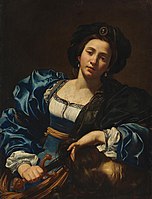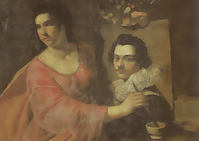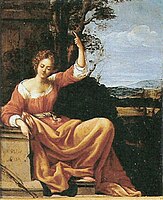Virginia Vezzi
Virginia Vezzi | |
|---|---|
 Portrait by Claude Mellan (1626) | |
| Born | 1600 Velletri, Italy |
| Died | October 17, 1638 Paris, France |
| Education | Father's studio |
| Known for | Painting, Drawing |
| Movement | Baroque |
Virginia Vezzi, sometimes given as Virginia da Vezzo (1600–1638), was an Italian painter, and the wife of French painter Simon Vouet.
Life in Italy
[edit]

Virginia Vezzi was born in Velletri on 24 June 1600 to Plinia Ferri, a midwife, and Pompeo Vezzi.[1] She may have had contact with the painter Antonio Vezzi, perhaps a relative of Pompeo.[1] Before 1611, her family moved to Rome, near the church of San Nicola in Arcione, because Virginia showed a talent for painting and her father thought she would be able to study in Rome.[1] Here she began the study of art, probably with Marco Tullio Montagna, an artist from Velletri, and with Cavalier d'Arpino, Gaspare Celio and Lanfranco.[1] From 1622 to 1626, Virginia's family lived in via Ferratina (via Frattina), near to the French painter Simon Vouet.[1] Simon was 10 years her senior, he taught life drawing at his house where he lived from 1623 to 1627.[2][1] Virginia was now 23 and an accomplished artist.[1] She visited Vouet's workshop to improve her technique; Cassiano dal Pozzo described her as Vouet's disciple.[1] She painted history paintings and miniatures, and also worked in pastel.[3]
In 1624, Virginia was inducted as a member of the prestigious painting Accademia di San Luca, a striking accomplishment for a painter of her youth and gender.[4] Her entrance piece was possibly a painting of the Old Testament heroine, Judith, the only certain autograph and datable painting by her: Judith with the Head of Holofernes (Musée des Beaux-Arts de Nantes), engraved by Claude Mellan in 1626.[5] Another version of the painting was auctioned at Christie's in 2006 for EUR 64,480.[6] In 1624, Simon was also elected president of the Academy.
In 1626, Virginia Vezzi and Simon Vouet were married in the church of San Lorenzo in Lucina, their home parish and also the church associated with French painters in Rome.[1] In this church, Vouet was responsible for the decoration of the Alaleoni Chapel; Virginia probably assisted him, particularly in the painting of the angels.[1] In 1626, Marcello Giovannetti, a friend of the couple, published a book of poems, including a sonnet dedicated to a painting of Danae by Virginia.[1]

Life in France
[edit]Virginia married Simon Vouet in Rome in 1626 and the following year moved with him to his native France, where Simon, as Premier peintre du Roi, was given lodgings in the Louvre in Paris. Virginia was "known for her beauty...and she often served as the model for her husband's Magdalenes, Madonnas, and mythological heroines." (See for example Virginia da Vezzo, the Artist's Wife, as the Magdalen at LACMA and Saint Cecilia in the Blanton Museum of Art).[7] She also "augmented the teaching activities of her husband by offering drawing lessons to young ladies of good family, thereby beginning a custom traditionally associated with the Louvre."[8]: 10–13
The seventeenth-century French scholar Isaac Bullart described her as
...Dame Romaine d'une beauté singuliere, et si bien instruite en l'Art de peindre qu'elle eut souvent l'honneur de travailler en la présence du Roy & de recevoir de sa bouche les loüanges qui estoient deües aux ouvrages de sa belle main, que la France voit encore dans les curieuses estampes qu’on en a mises au jour. (...a Roman lady of singular beauty, and so well instructed in the art of painting that she often had the honor of working in the presence of the King and receiving from his lips words of praise for the works of her beautiful hand, which France still sees in curious prints that have come to light.)[9]
It has been speculated that she may have played a role in her husband's atelier, but aside from the Self-Portrait or Muse attributed by Lollobrigida, there remains "a lack of evidence for her activity as a painter during her years in the French capital."[5]
Virginia and Simon had five children. She died prematurely in Paris 17 October 1638.[1]
Other paintings attributed to Vezzi
[edit]A handful of other paintings have been attributed to Vezzi. All but one are roughly datable to her years in Rome.
David Mandrella has suggested an attribution to Vezzi for another Judith, this one at the Alte Pinakothek in Munich (see Gallery), currently attributed to Simon Vouet,[6] but Mandrella's argument "does not convince" longtime Vouet/Vezzi scholar Arnaud Brejon de Lavergnée.[10]
Consuelo Lollobrigida attributes two other paintings to Vezzi, Self-portrait or Muse (1630-1632) in a French private collection (this would date to Vezzi's time in Paris; see Gallery), and an Allegory of Painting (c. 1620) in an Italian private collection, which Lollobrigida believes to be a self-portrait of Vezzi in the act of painting the young Simon Vouet (see Gallery).[2]
In 1992, Vouet specialist William R. Crelly suggested that Vezzi may have painted the Danaë at the Blanton Museum of Art in Austin (see Gallery).[11] Subsequently, a restoration of the painting uncovered a putto and an image of Jupiter that prompted the Blanton to attribute the Danaë to Jacques Blanchard (who painted another Danaë, at the Musée des Beaux-Arts de Lyon). But as recently as 2013, art historian Guillaume Kazerouni has disputed the Blanchard attribution and repeated the suggestion that the Blanton Danaë may be by Virginia Vezzi.[12][13]
Another painting, of a woman in a red dress with a blue cloak and a cream shawl (see Gallery), has been attributed to Vezzi by Kazerouni and another art historian, Adeline Collange, who both believe it may be a self-portrait; however, Arnauld and Barbara Brejon de Lavergnée do not believe the painting depicts Virginia Vezzi.[5]
An oil on copper Crucifixion has been listed as "attributed to Virginia Vezzi" by the Matthiesen Gallery in London (see Gallery).[14]
Gallery
[edit]-
Judith (c.1620-1625) by Simon Vouet (or Virginia Vezzi?), Alte Pinakothek.
-
Allegory of Painting (c. 1620), a self-portrait of Virginia Vezzi painting the young Simon Vouet?
-
Danaë (1620-1630) by Jacques Blanchard (or Virginia Vezzi?) at the Blanton Museum of Art.
-
The Blanton Danaë before the restoration that uncovered the putto and Jupiter.
-
Simon Vouet, fragment of a possible portrait of Virginia Vezzi (c. 1624-26), Gemäldegalerie, Berlin
-
Painting attributed to Virginia Vezzi, possibly a self-portrait.
-
Self-Portrait or Muse, attributed by Lollobrigida to Virginia Vezzi (1630-1632).
-
Crucifixion, oil on copper, "attributed to Virginia Vezzi" at the Matthiesen Gallery, London.
References
[edit]- ^ a b c d e f g h i j k l Sara, Bruno (2021). Le Signore dell'Arte: Storie di donne tra '500 e '600. Skira. p. 258.
- ^ a b Lollobrigida, Consuelo. "Virginia da Vezzo. Un inedito e qualche riflessione," Diana, nr. 2/2011, pp. 64-69.
- ^ Profile at the Dictionary of Pastellists Before 1800.
- ^ Rebecchi, Silvia (22 February 2015). "Quando il matrimonio è d'arte. Simon Vouet, Virginia da Vezzo e la sua 'Giuditta con la testa di Oloferne'". storiedellarte.com. Retrieved 2017-09-12.
- ^ a b c "Simon Vouet, Study of a Young Woman as the Virgin". sothebys.com. Retrieved 2019-10-18.
- ^ a b Virginia Vezzi, o da Vezzo (Velletri 1601-1638 Parigi), Giuditta (Christie's auction catalogue page)
- ^ "Saint Cecilia". Blanton Museum of Art. Retrieved 8 November 2021.
- ^ Crelly, William R. The Paintings of Simon Vouet. Yale University Press, 1962.
- ^ Bullart, Isaac. Academie des Sciences et des Arts, contenants les Vie et les Eloges Historiques des Hommes Illustres..., volume 2, "Simon Vouet," pp. 490-492. Paris, 1682.
- ^ Brejon de Lavergnée, Arnauld. "Simon Vouet. Nantes and Besançon" (review of the exhibition). The Burlington Magazine, Vol. 151, No. 1272 (Mar., 2009), pp. 187-189.
- ^ Crelly, William R. "Marcello Giovanetti: Sonnets et tableaux" in Simon Vouet: Actes du colloque international Galeries nationales du Grand Palais 5-6-7 février 1991, edited by Stéphane Loire, Paris: La Documentation Française, 1992, pp. 178-9.
- ^ Rykner, Didier. "A Work by Jacques Blanchard Identified in Austin". thearttribune.com. Retrieved 2019-10-18.
- ^ Rykner, Didier. "Judith and Holophernes by Virginia da Vezzo". thearttribune.com. Retrieved 2019-10-20.
- ^ "Crucifixion (Virginia Vezzo)". matthiesengallery.com. Retrieved 2019-10-26.
Further reading
[edit]- Michel, O. "Virginia Vezzi et l’entourage de Simon Vouet à Rome" in S. Loire (ed.), Simon Vouet: Actes du colloque international, Grand Palais, 5–7 February 1991, pp. 123–33.








